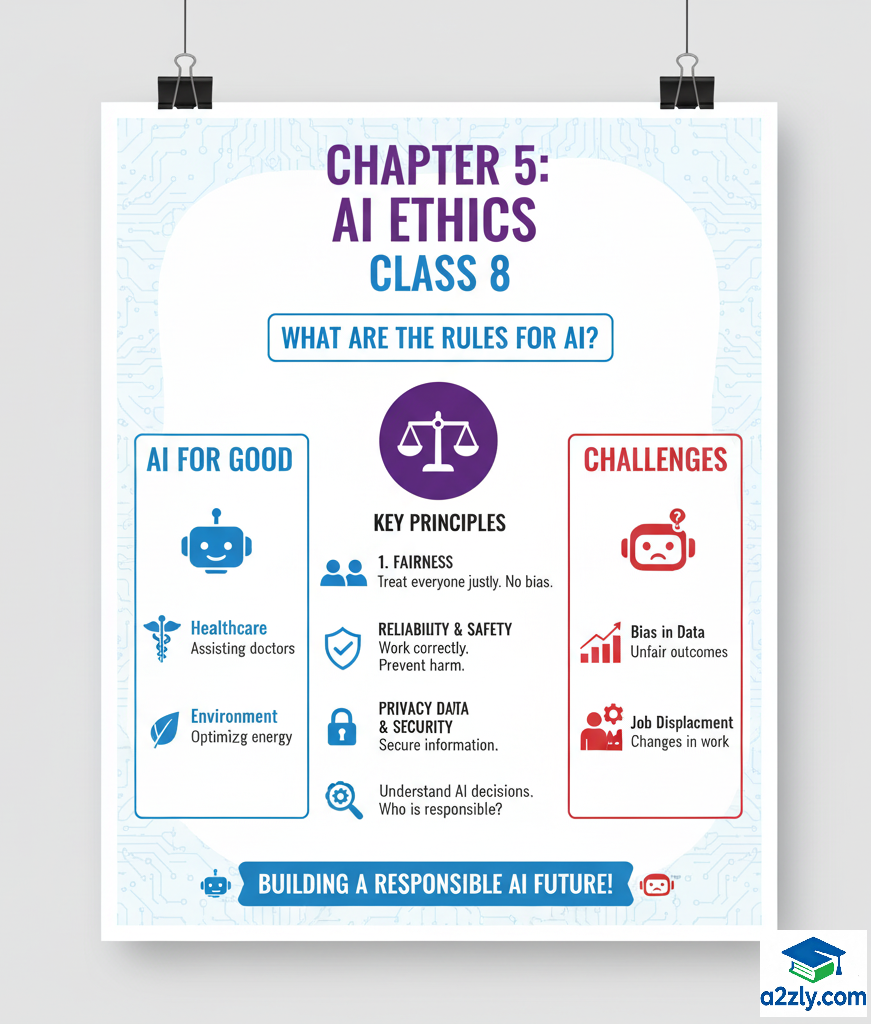🧭 Chapter Overview
AI has become a part of our daily lives — from recommending movies to driving cars.
But “Can we trust AI to always do what’s right?” 🤔
That’s where AI Ethics comes in.
It helps ensure AI systems are fair, transparent, safe, and beneficial for all humans.
5.1 What is AI Ethics?
💡 Definition:
AI Ethics refers to a set of moral principles and guidelines that help developers and users ensure responsible use of Artificial Intelligence.
It focuses on how AI should behave and how humans should use it.
⚖️ Purpose of AI Ethics:
| Purpose | Description |
|---|---|
| 🧠 Fairness | AI should treat everyone equally without bias. |
| 🔒 Privacy | Protect people’s data and personal information. |
| 💬 Transparency | AI decisions should be understandable. |
| 🤝 Accountability | Developers and users must take responsibility. |
| 🌍 Beneficence | AI must do good and avoid harm. |
🧠 Mind Map: What is AI Ethics
AI ETHICS
|
------------------------------------
| | | | |
Fairness Privacy Transparency Accountability Beneficence
5.2 Privacy and Data Protection
💡 Definition:
AI often collects and analyzes personal data (like names, faces, location, voice, etc.).
Privacy and Data Protection ensure this data is used securely and responsibly.
⚙️ How AI Uses Data:
- Collects data from phones, cameras, sensors.
- Learns patterns to give recommendations.
- Predicts behavior or preferences.
⚠️ Ethical Concern:
If AI stores or shares private data without consent, it can lead to privacy violations.
🛡️ Data Protection Practices:
| Practice | Description |
|---|---|
| Data Encryption | Protects information using codes. |
| Consent Mechanism | Takes user permission before data use. |
| Data Minimization | Collect only necessary information. |
| Right to Delete | Allow users to delete their data. |
🧠 Mind Map: Privacy and Data Protection
Privacy & Data Protection
|
-------------------------------
| | | |
Encryption Consent Minimization User Control
5.3 Accountability in AI
💡 Definition:
Accountability means identifying who is responsible for the actions and outcomes of AI systems.
⚖️ Why It Matters:
If an AI system makes a wrong decision (like rejecting a loan or causing an accident),
we must know who will be held accountable — the programmer, company, or user?
🧩 Key Elements of Accountability:
| Element | Description |
|---|---|
| Traceability | Every AI decision should be trackable. |
| Human Oversight | Humans should supervise AI systems. |
| Responsibility | Clear rules for AI developers & users. |
| Legal Frameworks | Governments must make AI laws. |
🧠 Mind Map: Accountability
Accountability in AI
|
---------------------------------
| | | |
Traceability Oversight Responsibility Legal Rules
5.4 AI and Jobs
💡 Ethical Concern:
AI can automate tasks — helping industries work faster, but also replacing human jobs.
⚙️ Positive Impact:
- Creates new tech-based jobs (AI engineers, data analysts).
- Reduces human error and increases safety.
⚠️ Negative Impact:
- Job loss in repetitive sectors (factories, data entry).
- Inequality if workers are not re-skilled.
💬 Ethical Solution:
- Upskill workers with AI knowledge.
- Use AI to assist humans, not replace them.
🧠 Mind Map: AI and Jobs
AI and Jobs
|
-------------------------------
| | |
Positive Negative Ethical Use
Impact Impact (Upskilling)
5.5 Deepfakes and Misinformation
💡 Definition:
Deepfakes are AI-generated fake images, videos, or voices that look and sound real.
Misinformation is false or misleading information spread through AI platforms.
⚠️ Ethical Risks:
| Issue | Description |
|---|---|
| Fake News | Misleads people about real events. |
| Identity Theft | Creates fake videos of real people. |
| Political Manipulation | Spreads lies during elections. |
| Loss of Trust | Reduces faith in real information. |
🧩 AI Countermeasures:
- AI fact-checkers and detection tools.
- Digital watermarking and authenticity labels.
🧠 Mind Map: Deepfakes & Misinformation
Deepfakes & Misinformation
|
-----------------------------------
| | | |
Fake News Identity Politics Solutions
Theft Impact (AI Detection)
5.6 Ethical Use of AI in Autonomous Machines
💡 Definition:
Autonomous machines like self-driving cars or drones make decisions without direct human control.
AI ethics ensures those decisions are safe and fair.
⚙️ Ethical Dilemmas:
| Situation | Dilemma |
|---|---|
| Self-Driving Car | Whose safety should the car prioritize in an unavoidable accident? |
| Military Drones | Should machines make life-and-death decisions? |
| Healthcare Robots | Should robots override human medical orders? |
🧩 Ethical Guidelines:
- Human supervision must always be possible.
- AI decisions should follow safety-first rules.
- AI must never harm humans intentionally.
🧠 Mind Map: AI in Autonomous Machines
Ethical AI in Autonomous Machines
|
---------------------------------
| | | |
Safety Human No Harm Responsibility
Priority Control
5.7 AI and Inclusivity
💡 Definition:
Inclusivity in AI means making AI systems that are fair and accessible to everyone, regardless of gender, language, race, or disability.
⚖️ Why It Matters:
If AI is trained on limited data, it might ignore or misrepresent certain communities.
🧩 Ways to Ensure Inclusivity:
| Approach | Description |
|---|---|
| Diverse Datasets | Include all groups and languages. |
| Accessibility Features | Voice assistants for the visually impaired. |
| Cultural Neutrality | Avoid stereotypes in AI design. |
| Gender-Neutral AI | Use inclusive language (e.g., not only “he”). |
🧠 Mind Map: AI and Inclusivity
AI and Inclusivity
|
--------------------------------
| | | |
Diverse Accessible Neutral Fair
Data Design Language Use
5.8 AI in Surveillance
💡 Definition:
AI-based surveillance systems monitor public or private spaces using cameras and sensors.
Used in security, law enforcement, and public safety.
⚠️ Ethical Concerns:
| Concern | Description |
|---|---|
| Privacy Violation | People being monitored without consent. |
| Misuse of Power | Governments or companies using data for control. |
| Bias in Detection | Misidentifying people based on race or gender. |
🧩 Ethical Practices:
- Use surveillance only for safety.
- Inform people about monitoring.
- Follow legal and transparent procedures.
🧠 Mind Map: AI in Surveillance
AI in Surveillance
|
-------------------------------
| | | |
Privacy Transparency Safety Fairness
5.9 Can AI Be Creative? (Ethical Dilemma)
💭 Question:
If AI writes stories, paints, or composes music — who owns that creation?
💡 Ethical Dilemma:
| Issue | Description |
|---|---|
| Authorship | Should credit go to AI or the human programmer? |
| Originality | AI learns from existing art — is it truly creative? |
| Copyright | Can AI-generated content be copyrighted? |
🧠 Balanced View:
AI can assist in creativity, but true human imagination and emotion still remain unique.
🧠 Mind Map: AI Creativity Dilemma
AI Creativity Dilemma
|
-----------------------------
| | | |
Authorship Originality Copyright Human Emotion
5.10 Future Challenges in AI Ethics
As AI grows, new ethical issues will arise.
We must prepare to handle them wisely.
🚀 Future Ethical Challenges:
| Challenge | Description |
|---|---|
| AI Autonomy | Machines making major decisions independently |
| Data Ownership | Who owns the massive data used by AI? |
| Bias in Generative AI | AI creating biased or harmful content |
| Digital Divide | Unequal AI access between rich and poor nations |
| AI and Human Rights | Ensuring AI never violates dignity or freedom |
💬 Need for Global AI Ethics:
Organizations like UNESCO, EU, and IEEE are creating global ethical standards for AI.
🧠 Mind Map: Future AI Ethics Challenges
Future Challenges in AI Ethics
|
----------------------------------------
| | | | |
Autonomy Data Bias Rights Equality
Ownership
📘 Summary Table: Chapter 5 – AI Ethics
| Section | Topic | Key Idea |
|---|---|---|
| 5.1 | What is AI Ethics | Moral principles guiding responsible AI |
| 5.2 | Privacy & Data Protection | Keep user data safe and used with consent |
| 5.3 | Accountability | Humans must be responsible for AI decisions |
| 5.4 | AI and Jobs | Balance automation with human employment |
| 5.5 | Deepfakes & Misinformation | Prevent fake content and identity misuse |
| 5.6 | Autonomous Machines | Ensure AI decisions are safe and supervised |
| 5.7 | Inclusivity | Make AI accessible and fair to all groups |
| 5.8 | Surveillance | Respect privacy and transparency in monitoring |
| 5.9 | AI Creativity | Debate over AI’s originality and authorship |
| 5.10 | Future Challenges | Ethical governance and human-AI balance |
✅ Key Takeaways
- AI Ethics ensures responsible and fair AI use.
- It focuses on privacy, accountability, inclusivity, and fairness.
- Deepfakes, bias, and data misuse are major ethical threats.
- Humans must always remain in control of AI decisions.
- The future of AI ethics depends on global cooperation and strong moral leadership.
🧠 Complete Mind Map: AI Ethics Overview
AI ETHICS
|
----------------------------------------------------------------
| | | | | | |
Privacy Accountability Jobs Deepfakes Inclusivity Creativity Future
& Data & Fairness & Info & Fair AI Dilemmas Issues

